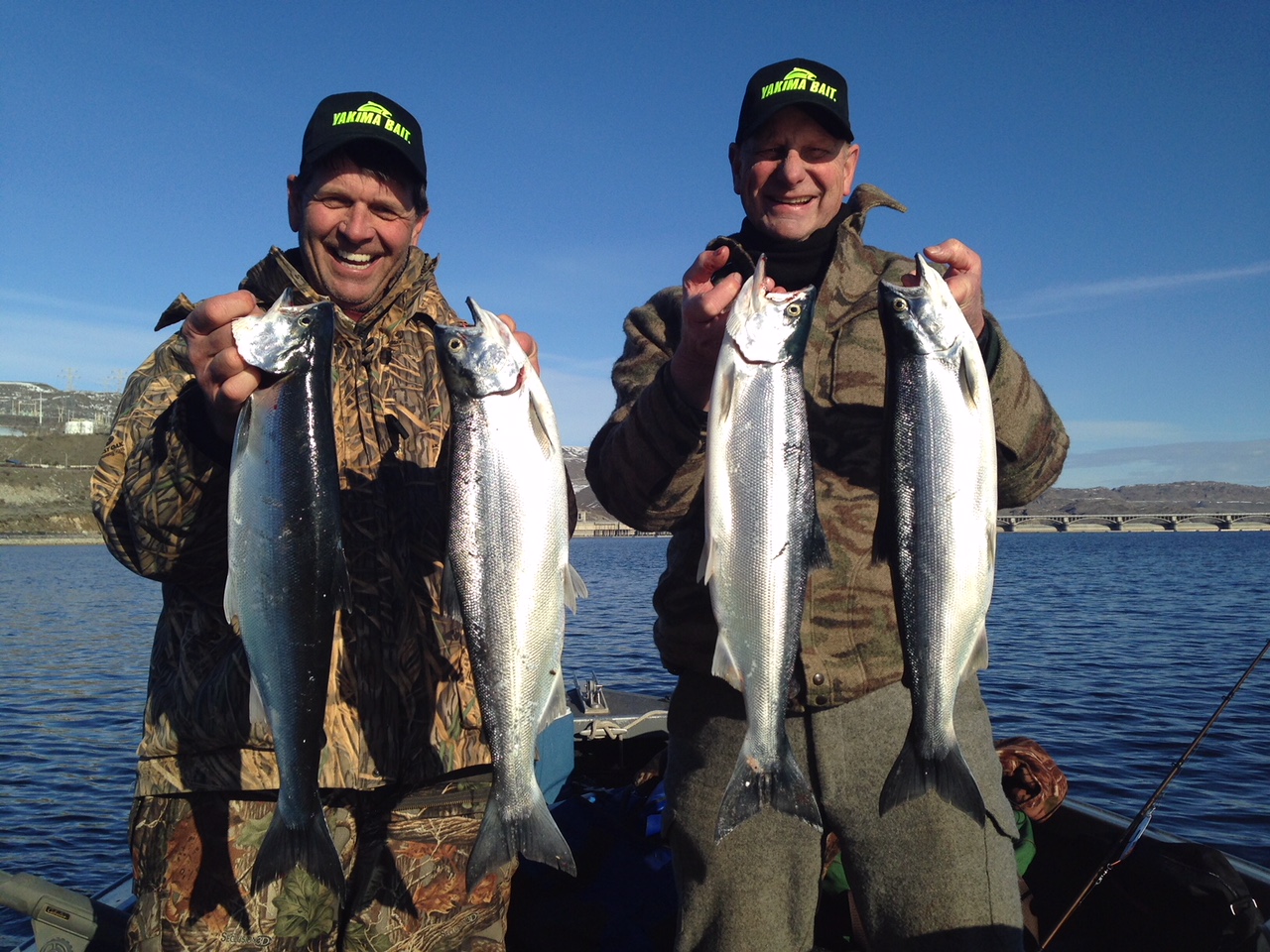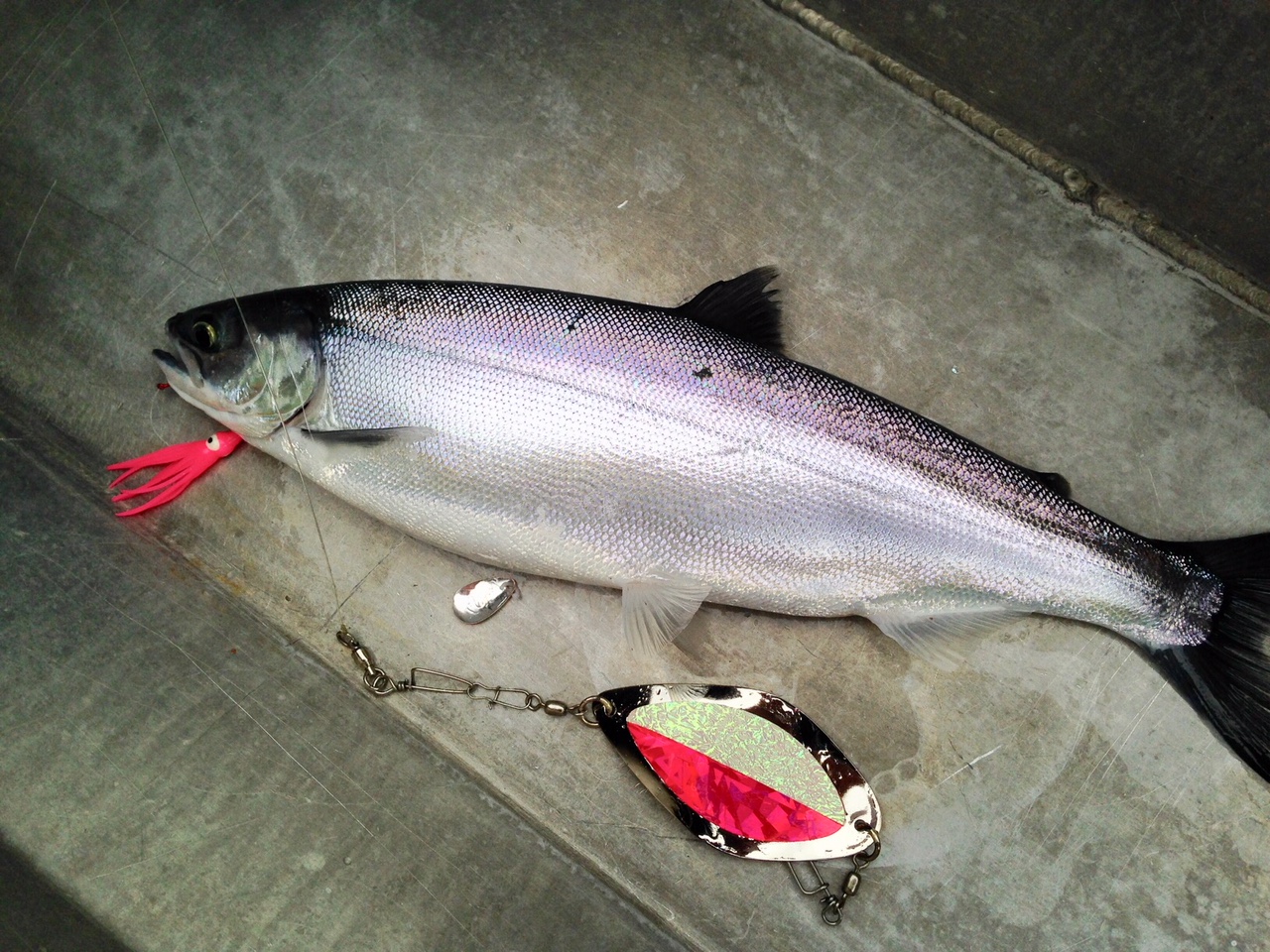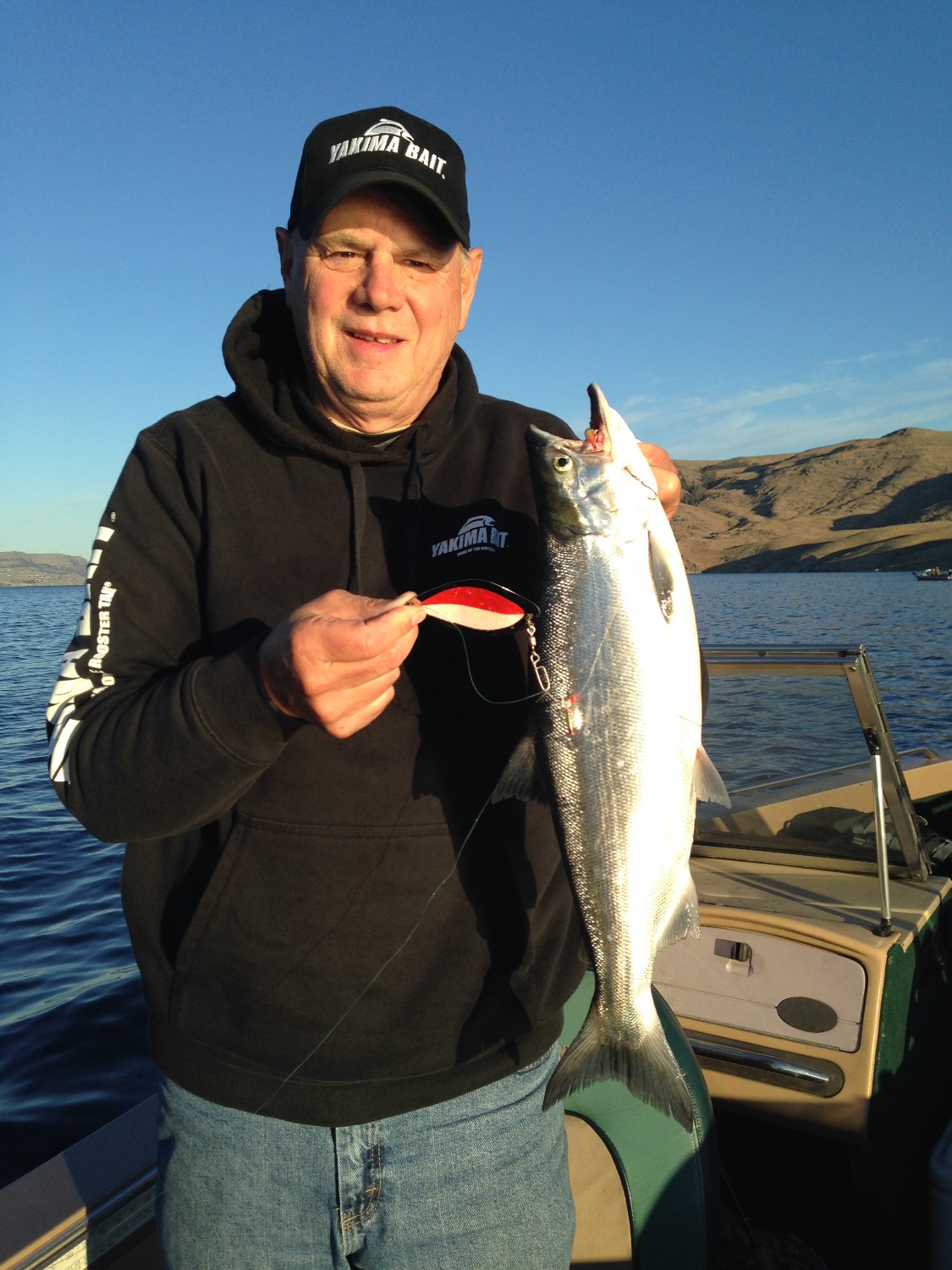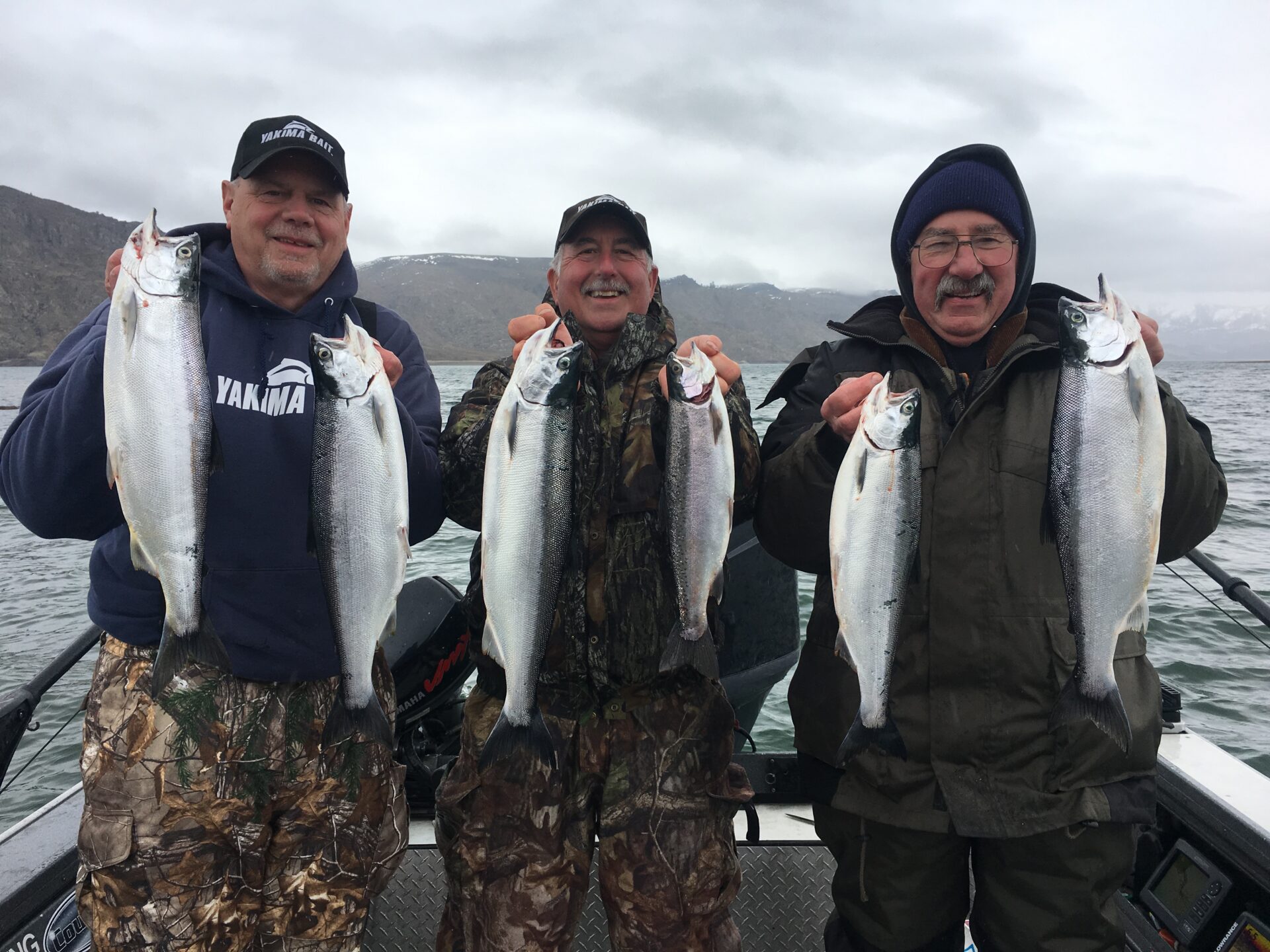Trophy Kokanee
The popularity of kokanee fishing in the western United States has been growing by leaps and bounds over the past several years. There are plenty of reasons for all the new kokanee fishing enthusiasm. First is, kokanee can be caught almost year round. They are willing biters and are excellent eating. And, with many salmon runs dwindling kokanee fishing offers anglers another viable option.

These happy anglers caught these really nice kokanee trolling on the surfacewith Tight Line Kokanee Rigs and Fast Limit dodgers.
Kokanee are a land-locked sockeye salmon that are native to some lakes in the West. Many other lakes and reservoirs have received plantings of kokanee, which adapt well to large, cool reservoirs. Lakes and reservoirs in Washington, Oregon, California, Utah, Montana, Wyoming and Nevada all offer anglers a chance to catch these popular fish.
While the kokanee in most lakes might run from 10- to 16-inches in length, there are some lakes that will put out much bigger kokanee. And many of those bigger fish have been caught in the last few years.
The current world record kokanee was caught in Oregon’s Lake Wallowa back in 2010. The monster fish weighed 9-pounds, 10-ounces. A bigger fish was actually caught last year in British Columbia, but the angler didn’t determine it was actually a kokanee until after he had eaten some of it, thinking it was a rainbow, not a salmon.
In Washington State, Lake Roosevelt has been putting out some large kokanee the past few years, with fish running from 3- to 6-pounds in size. The big reservoir above famous Grand Coulee Dam seems to be perfect for growing big fish.

A fat kokanee taken on a Tight Line Kokanee Spinner and Fast Limit dodger.
Depending on the time of year, and where the food is in the lake, kokanee can be found anywhere from the surface to depths of 200 feet or more. In the colder months the fish will often times feed right on the surface. When that occurs it is crucial that lures and bait get put way back behind the boat because the fish will spook when the boat goes over them on the troll, but will filter back to where they were after a short time.
For example, at Roosevelt earlier this year we were running our flat lines 200 feet off the stern, with the lines on the downriggers out 80 feet. We also had good luck running some lines on side-planers, putting them out 120 feet behind the planers.
When the fish are deeper, then it is time to deploy the downriggers. A good fish finder will help spot schools of fish, and that will tell you how deep to run your lines.

The author with a nice kokanee taken from Washington’s Lake Roosevelt. The big reservoir above Grand Coulee Dam is one of the West’s premier kokanee fishery.
As fishing for kokanee has become more popular there have been many new lures created to help catch them. Back in the day you could use a small spinner tipped with a maggot behind some gang trolls and catch fish. Today there are all kinds of kokanee specific lures and attractors.
Over the past few years one of the most productive combinations has been a Fast Limit dodger placed anywhere from 12 to 36-inches ahead of a Tight Line Kokanee Rig tipped with shoe peg corn.
The Fast Limit dodger is made by Yakima Bait and comes in a variety of color combinations. The dodger swings back and forth giving a seductive swimming motion to the spinner trailing.
Other good attractors are Worden’s 0000 and 000 dodgers. Again, these dodgers give a good swinging action that attracts the kokanee in, and then gives an alluring motion to the lure behind.
The Tight Line Kokanee Rig features a UV-coated, hammered Indiana blade, and a 1-1/2” Yamashita squid body with two extra sharp red hooks tied on 10-pound test Fluorocarbon leaders. It comes in two blade sizes and 15 color combinations.
Veteran kokanee anglers have been adding a small Spin-N-Glo ahead of a fly or hoochie/squid for a long time, and now Yakima Bait is building a special Spin-N-Glo Kokanee Rig that includes a Spin-N-Glo ahead of a UV impregnated Yamashita squid body on a pre-tied Fluorocarbon leader. The rig comes in 10 of the most popular kokanee color combinations.
The Spin-N-Glo Kokanee Rig comes in two sizes with a size 10 or a size 12 Spin-N-Glo.
Most kokanee anglers will tip the rigs with shoe peg corn, maggots, Berkley grubs or a combination of those. The latest rage is to die the shoe peg corn red, or pink, or chartreuse, and some of the top kokanee guides are also adding a variety of scents to their baits.
Trolling speed is another factor on catching kokanee. Normally a slow troll is preferred. Trolling speeds of 1 to 1.75 miles per hour is good. And, trolling in an “S” pattern will help to get strikes too.
Kokanee have very soft mouths, so they are notorious for jumping and spitting the hook. On bad days a hook-to-land ratio might be 50%. The best advice to having fish stay on is us a long, light-tipped limber rod and keep the pressure on them. A long-handled net will help save some of the fish that want to jump and spit the hook right at the back of the boat.
Kokanee are fun fish to catch, and they are fantastic eating. Just about every one of the western States has lakes and reservoirs offering kokanee fishing. And some have some really big fish.

When the big kokanee are biting it is all smiles. These nice fish (all kokanee and one smaller rainbow) were caught in Lake Roosevelt in Northcentral Washington State.
There’s never been a better time to try for a trophy kokanee. Fish measured by the pound, instead of the inch are being caught every year. Just make sure you know how to identify a kokanee if you do catch a big one, because you don’t want to be grilling a potential record fish.
# # #
